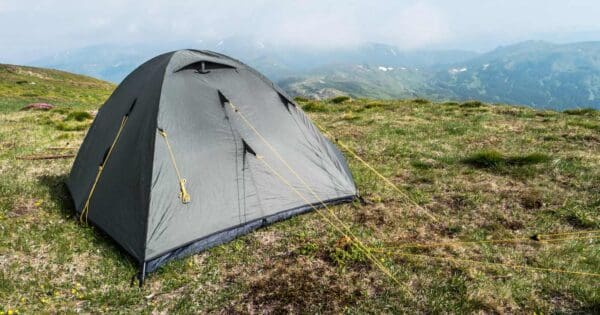Why put a mat under your sleeping bag?
Sleeping mats (or pads) cushion you, but more importantly, they block thermal transfer between you and the ground. Your sleeping bag, how advanced it may be, could not preserve all your body heat if it is in direct contact with a cold surface.
Your sleeping mat should prevent this. It consists of either closed cell foam or is inflatable to use air as an insulator. Both methods work, yet self-inflatable mats like our mountain mats offer better insulation. With die cut they are also lighter and more compact.
When choosing a sleeping mat, you have to consider your activity and what will be most important. A thicker mat will have a greater thermal resistance rating (it will be warmer!), but this also means you may have to compromise with extra weight. The most important things that will affect your choices are: R-rating (thermal resistance rating – the higher the number the warmer it is), packed volume, and weight.
Mat Construction
You use sleeping mats for two major reasons: cushioning hard ground and insulation against cold from below. But what size and shape do you need?
Length and width of your mat should be selected according to your body. On a standard mat you can rest your entire body. It will be more comfortable but heavier than a small mat. If saving weight is an important issue, ensure you at least fit your hips and shoulders onto a small mat.
If you tend to toss and turn in your sleep, you might experience a cold awakening – ending up beside your sleeping mat. A wider or mummy shaped mat like the MD Pro will help solve this problem.
Choosing the right sleeping mat
Choosing the right sleeping mat for overnight hikes is crucial for a comfortable and restful night’s sleep in the outdoors. Your choice should consider factors such as insulation, weight, packability, comfort, and durability. Here are some tips to help you make an informed decision:
- Insulation (R-Value): The R-value measures a sleeping mat’s insulation capability. Higher R-values indicate better insulation for colder conditions. Choose a mat with an appropriate R-value for the expected temperatures. For summer hikes, a lower R-value may suffice, but for colder seasons, go for a higher R-value mat.
- Type of Mat: There are three main types of sleeping mats: foam, self-inflating, and air mats. Each has its advantages and disadvantages:
- Foam Mats: These are lightweight and inexpensive but offer limited comfort and insulation.
- Self-Inflating Mats: These combine foam with air, offering a balance between comfort and insulation. They are usually heavier and bulkier than foam mats but more comfortable.
- Air Mats: These mats are the lightest and most comfortable but may lack insulation. Some models come with insulated options.
- Weight and Packability: Consider the weight and pack size of the mat, especially if you’re carrying it in your backpack. Lightweight and compact mats are ideal for backpacking.
- Inflatability: Air mats require inflation, either manually or with a pump. Consider the ease of inflation and whether you need to carry extra equipment like a pump or a repair kit.
- Length and Width: Choose a mat that suits your height and sleeping style. Some hikers prefer full-length mats for extra comfort, while others opt for shorter, torso-length mats to save weight and space.
- Durability: Look for mats made from robust materials that can withstand rough terrain and potential punctures. Reinforced or puncture-resistant mats are a good choice for extended hikes.
- Comfort: Comfort is essential for a good night’s sleep. Test the mat in-store if possible or read reviews to get an idea of its comfort level. Consider the mat’s thickness and surface texture.
- Noise: Some air mats can be noisy when you shift around during the night. If noise bothers you, consider quieter alternatives.
- Price: Sleeping mats come in a wide price range. While it’s essential to stay within your budget, remember that investing in a quality sleeping mat can significantly impact your overall hiking experience.
- Brand and Reviews: Research different brands and read reviews from other hikers to get a sense of the mat’s performance and durability.
- Seasonality: Some mats are designed specifically for certain seasons or conditions. Make sure the mat you choose is suitable for the season and terrain you’ll be encountering.
- Warranty and Customer Service: Check if the manufacturer offers a warranty and good customer service in case you encounter issues with your mat.
Ultimately, the best sleeping mat (or pad) for overnight hikes will depend on your specific needs, budget, and the conditions you expect to encounter. Make sure to test the mat before your hike to ensure it meets your comfort and insulation requirements.






Here’s a couple I’ve field tested.
Nemo Tensor Ultralight Sleeping Pad
https://www.trailhiking.com.au/gear-reviews/nemo-tensor-ultralight-sleeping-pad/
Klymit Insulated Static V Lite Sleeping Pad
https://www.trailhiking.com.au/gear-reviews/klymit-insulated-static-v-lite/